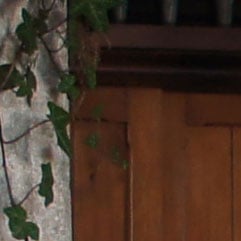Olympus E-PL3
-
-
Written by Gordon Laing
Quality
Olympus Pen E-PL3 vs Panasonic Lumix GF3 vs Sony Alpha NEX-C3 Resolution
|
Olympus Pen E-PL3 | Panasonic Lumix GF3 | Sony NEX-C3 | ||
 |  | |||
f5.6, 200 ISO | f5.6, 160 ISO | f5.6, 200 ISO | ||
 |  |  | ||
f5.6, 200 ISO | f5.6, 160 ISO | f5.6, 200 ISO | ||
 |  |  | ||
f5.6, 200 ISO | f5.6, 160 ISO | f5.6, 200 ISO | ||
 |  |  | ||
f5.6, 200 ISO | f5.6, 160 ISO | f5.6, 200 ISO |
Olympus Pen E-PL3 vs Panasonic Lumix GF3 vs Sony AlphaNEX-C3
Noise
The above shot was taken with the the Olympus Pen E-PL3 in Program auto mode. The 14-42mm f3.5-5.6 kit lens was set to its widest angle focal length, the sensitivity was set to 200 ISO and the exposure was one second at f3.5. The crops are taken from the area marked with the red square and presented below at 100%. The Pen E-PL3 has given this scene a stop more on the exposure than the Lumix GF3 and Sony NEX-C3, and the result is much better detail in the shadows and the area from which our crop is taken. On the base 200 ISO crop the detail is very good but the slight graininess that was apparent in the outdoor crops is also present here. It isn’t obtrusive and it doesn’t obscure any of the image details, but it’s a definite characteristic of the E-PL3’s 12.3 Megapixel CMOS sensor and processing. There’s still good detail at 400 ISO, but that graininess is now much more apparent. It’s most evident in the wood panelling, but its effect on fine image detail is still fairly negligible. At 800 ISO it’s beginning to gain the upper hand though and at 1600 ISO there’s no question that this is an image shot at a high ISO setting. Despite that, even the 160 ISO crop isn’t unpleasant, there’s a good balance between suppression and image detail and the quality of the noise isn’t harsh. As you’d expect, it gets much worse from 3200 ISO upwards with the noise gaining a colour component in addition to the luminance noise of the mid ISO range. Compared with the Panasonic Lumix GF3 the Olympus Pen E-PL3 crops look brighter, but it’s hard to tell if there’s more detail in the slightly underexposed GF3 crops. Certainly at 160 and 200 ISO the GF3 crops don’t show much evidence of noise. Like the E-PL3 the Lumix GF3 does a great job of striking a balance between noise supression and detail retention right up to 1600 ISO, but the crops look at little softer and less detailed than those from the E-PL3. Beyond that, things even up a bit, but over most of the ISO sensitivity range the Pen E-PL2 is a clear winner over the Lumix GF3. Compared with the Sony Alpha NEX-C3 the Pen E-PL3 looks every bit as good as the bigger-sensor NEX-C3 at the lower sensitivity levels. At 200 ISO it’s too close to call, though arguably the Pen E-PL3 has the better of it. Beyond 400 ISO though, the NEX-C3’s bigger sensor advantage begins to tell. There’s still very good detail in the E-PL3 crops, but it’s being maintained by image processing that’s becoming just a little bit intrusive, certainly compared to the NEX-C3 crops. Another thing worth bearing in mind if good low light performance is important to you is that the NEX-C3 has two composite low light modes shown in the final two crops. Hand-held Twilight and Anti Motion Blur both provide a significant improvement in image quality over what you’d get in a single-shot mode with a high ISO setting. We’ve included the Pen E-PL3’s (non-composite) DIS low light mode for comparison. Now head over to our Olympus E-PL3 sample images to see some more real-life shots in a variety of conditions.
|






























